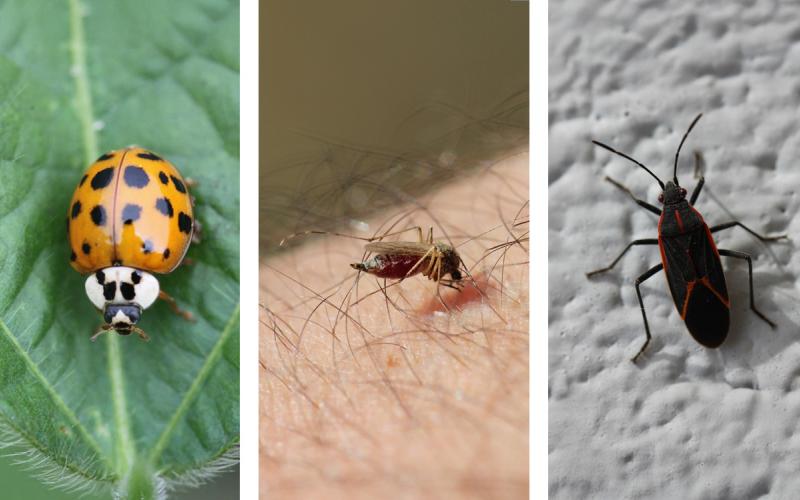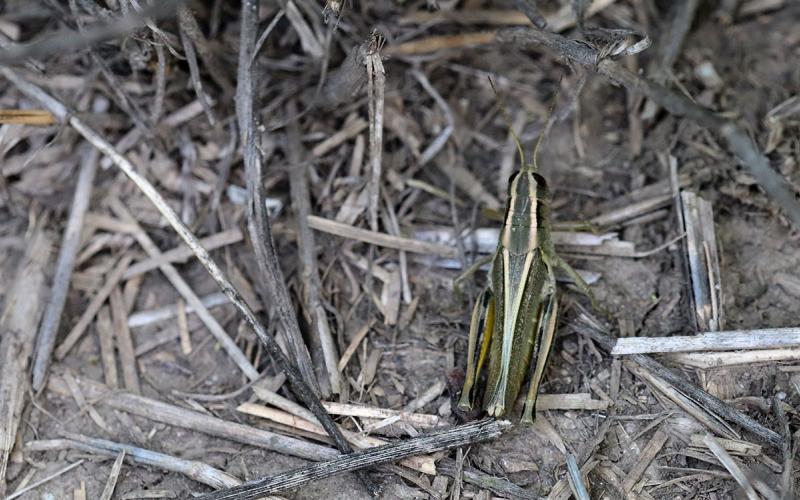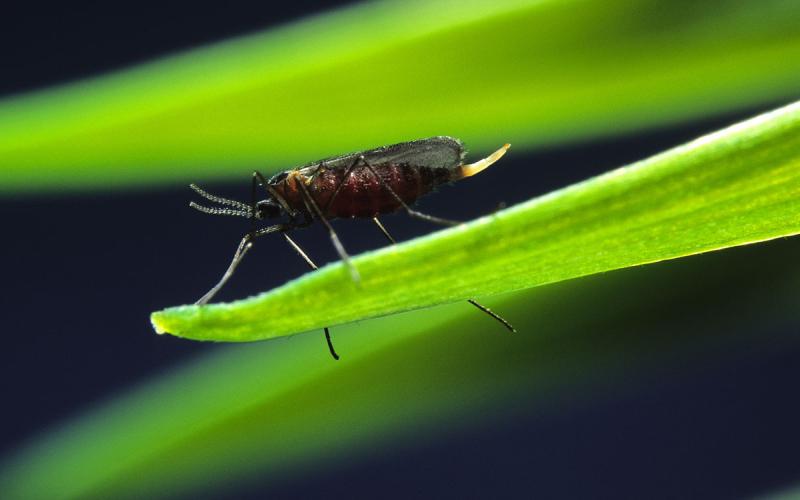South Dakota winter wheat planting is currently underway, and with it comes the need to consider management practices that may reduce pest populations. Although we cannot predict aphid pressure in winter wheat, there are measures that may be taken to reduce the risk associated with these insects.
Common Aphids in South Dakota
There are four species of aphids that are capable of infesting winter wheat in South Dakota. They are the bird cherry oat aphid (Figure 1), English grain aphid (Figure 2), greenbug (Figure 3), and Russian wheat aphid (Figure 4). Although these aphids are capable of negatively impacting yield through direct feeding, the bird cherry oat aphid, English grain aphid, and greenbug are also vectors of Barley yellow dwarf virus (BYDV). After emergence, it is important to scout fields for the presence of these aphids.

Bird Cherry Oat Aphid
This species of aphid is olive to dark green and can be identified by the characteristic red-orange patch that is present on the base of its abdomen near its cornicles (tailpipes). Bird cherry oat aphid populations have been observed in corn fields this year, and may transition to winter wheat as corn matures.
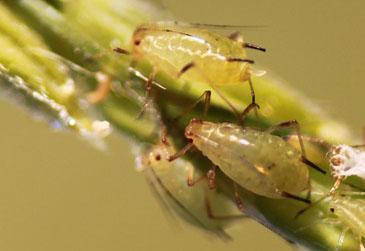
English Grain Aphid
This species of aphid can vary in color from light green to brown. They can be identified by their black cornicles, black and green alternating segments of the antennae, and black leg joints.
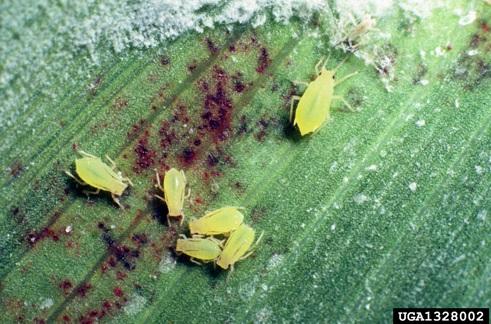
Greenbug
This species of aphid is light green in color, and can be identified by the dark green stripe present on its back. Feeding by this aphid causes yellow discoloration and red spots on the leaves due to a toxin present in its saliva.
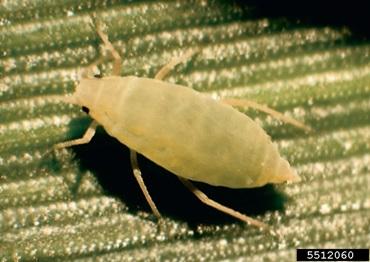
Russian Wheat Aphid
This species of aphid is a dusty blue-green color and can be identified by its short antennae and greatly reduced cornicles. Due to a toxin in its saliva, feeding by this aphid causes long white or yellow streaks to appear on the leaves. Plants infested by this aphid will exhibit a purple color during cold weather.
Management
Cultural Preventative Practices
Field sanitation is important for reducing the risk of aphid infestations in winter wheat. Volunteer cereals should be removed from the field prior to planting. These volunteer plants can serve as a refuge and allow aphid populations to build up and easily move to newly emerging wheat. Even if aphid populations are reduced, it is possible for aphids to move into a target field from infested neighboring fields.
Resistant wheat varieties exist for the Russian wheat aphid, but not for the other three aphid species that are present in South Dakota. Delayed planting is an additional option for reducing the risk of aphid infestation. In South Dakota, optimal winter wheat planting is from September 10 to October 10. Delaying winter wheat planting to September 20 or later reduces the chances for aphid infestation, which in turn reduces the incidence of BYDV.
Insecticide Seed Treatment
Another management option for aphid pests of winter wheat is the use of systemic insecticides as seed treatments (Table 1). Although these insecticides will not be effective for the entire fall season, they do have the potential to reduce early aphid infestations. Because the insecticides are present in the plant tissue, they are reported to reduce the incidence of BYDV by removing aphid populations.
| Insecticide (active ingredient) |
Rate (for aphids) |
| Cruiser 5FS (thiamethoxam) |
0.75 to 1.33 fluid oz. per 100 lbs. seed |
| CruiserMaxx Cereals (thiamethoxam + fungicides) |
5.0 fluid oz. per 100 lbs. seed + 0.48 to 1.0 fluid oz. Cruiser 5FS |
| Gaucho 600 (imidacloprid) |
0.8 to 2.4 fluid oz. per 100 lbs. seed |
| Gaucho XT (imidacloprid + fungicides) |
3.4 to 4.5 fluid oz. per 100 lbs. seed |
Scouting
When scouting a field for the presence of aphids, begin sampling near the edge of the field and walk in a “W” or “Z” pattern. Randomly choose five plants to examine along each leg of the pattern. These pests are commonly found on the stems and undersides of leaves. For fall infestations, aphids tend to hide at or below ground level on wheat stems. Count the number of aphids observed on each plant. At the end of sampling, calculate the average number of aphids per plant. See Table 2 for the economic thresholds for the pest aphid species and brown wheat mite.
If a pest population is above the economic threshold, management should be considered. Prior to insecticide application, check the weather forecast. Warm fall conditions may encourage continued pest pressure. See Table 3 for insecticides that are labeled for aphids on wheat.
| Pest |
|
|
| Seedling stage | Boot to heading | |
| Bird cherry oat aphid | 20 | 30 |
| English grain aphid | 30 | 50 |
| Greenbug | 5-15 | 25 |
| Russian wheat aphid | 5-10 | 20-30 |
| Insecticide (active ingredient) |
Restricted Entry Interval (hours) |
| Baythroid XL2 (beta-cyfluthrin) |
12 |
| Besiege (lambda-cyhalotrhin and chlorantraniliprole) |
24 |
| Cobalt Advanced (chlorpyrifos and lambda-cyhalothrin) |
24 |
| Dimate 4E (Dimethoate) |
48 |
| Karate with Zeon Technology (lambda-cyhalothrin) |
24 |
| Lorsban Advanced (chlorpyrifos) |
24 |
| Mustang Maxx2 (zeta-cypermethrin) |
12 |
| Nufos 4E (chlorpyrifos) |
24 |
| Proaxis (gamma-cyhalothrin) |
24 |
| Respect EC (zeta-cypermethrin) |
12 |
| Silencer (lambda-cyhalothrin) |
24 |
| Stallion (zeta-cypermethrin and chlorpyrifos) |
24 |
| Warrior II with Zeon Technology (lambda-cyhalotrhin) |
24 |
| *This list is not meant to be comprehensive. Always read and follow label instructions. | |
References:
- Blodgett, S., and J. Kieckhefer. 2012. Insect pests of wheat. In Clay, D. E., C. G. Carlson, and K. Dalsted (eds). iGrow Wheat: Best Management Practices for Wheat Production. South Dakota State University, SDSU Extension, Brookings, SD.
- Hein, G., and J. Thomas. 2006. Insecticides for control of aphids in wheat. CropWatch. University of Nebraska-Lincoln.
- Summers, C. G., and L. D. Godfrey. 2014. Small grains: Russian wheat aphid. UC IPM Pest Management Guidelines: Small Grains. UC ANR Publication 3466
